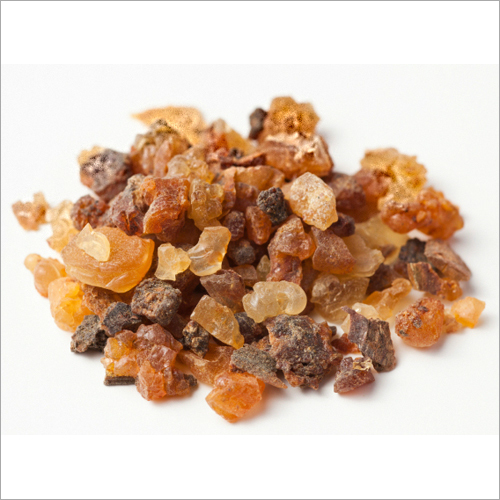Myrrh, Classification, Formation, Sources, Chemical Constituents, Identification Test, Adulterants and Uses for GPAT Exam
Myrrh
Synonyms :-
Gum Myrrh, Commiphora, Bissabol

Biological Sources :-
It is a gum resin obtained from the stem of Commiphora molmol Engier.
Family :-
Burseracae
Geographical source:-
It is mainly collected from Somaliland in the north east of Africa and south of Arabia.
Collection and Preparation:-
- The oleo gum resin is collected into lysigenous cavities.
- The schizogenous ducts form lysigenous cavity by the breakdown of bark.
- The gum exudes out upon wounding of bark and changes its colour from yellowish white to reddish brown and forms hard mass.
- The gum is collected on goat skin and marketed.
Description :-
Shape:- Irregular rounded tears
Size:- 2.5 to 10 cm in diameter.
Texture:- Rough, dull and dusty surface.
Fracture:- Brittle, granular fracture.
Colour:- Reddish brown.
Odour:- Agreeable aromatic.
Taste:- Unpleasant, aromatic, bitter, acrid.
Chemical Constituents :-
The drug contains mixture of resin (25%), volatile oil (2.5-6.5%) and gum (60%). Along with these compounds, three free resin acids α, β and γ-Commiphoric acids, esters of resin
acid, commiphorinic acid, two phenolic resins α and β-heerabomyrrhol, volatile oil consist terpene, cuminic aldehyde and eugenol etc.
Chemical Test :-
1. A yellowish brown emulsion forms upon trituration with water.
2. Take 0.1gm of drug and 0.5 gm sand, triturate it with ether and filter it. Evaporate the filterate and add bromine vapour, violet colour develops.
Uses :-
It has stimulant, antiseptic property, uterine stimulant, emmenagogue. Due to its astringent property to mucous membrane it is also used for mouth wash and gargles.
Adulterants :-
The substituents of myrrh are fadhli or Arabian myrrh, Yemen myrrh, perfumed bdellium or bissabol, Indian bdellium, African bdellium and Gum hotai etc.
MCQ
1. Myrrh belong to family
A. Apoaceae
B. Solanaceae
C. Liliaceae
D. Burseracae
2. Which of the following is synonymous of Myrrh ?
A. Devil Dung
B. Vinca Rosea
C. Bissabol
D. Pannax
3. Which of the following is adulterant of Myrrh?
A. Indian Ginseng
B. Indian bdellium
C. Indian bdelium
D. Mulethi
4. Which of the following is not use of Myrrh?
A. Expectorant
B. Anti septic
C. Utrine Stimulation
D. Astringent
5. Myrrh is
A. Ester Resin
B. Acid Resin
C. Gum Resin
D. B and C
6. Which of the following is false sentence about Myrrh ?
A. It is irregular round shape.
B. It is reddish brown colour.
C. It is contain 70% Gum.
D. It is contain 60% Gum.
7. Which duct is secreted resin?
A. Schizogenous Duct
B. Parenchyma Duct
C. A and B
D. None of the above
8. Which of the following is major chemical constituents of myrrh ?
A. Heerabomyrrhol
B. Commiphoric Acid
C. Eugenol
D. Cumini Aldehyde
9. Which of the following is true about Myrrh ?
A. It is Ester Resin.
B. It is mainly collected in Europe.
C. The gum is collected in Cat.
D.The gum is collected on goat skin.
10. Which of the following market products containing myrrh ?
A. Toothpaste
B. Soap
C. Shampoo
D. Gargles
List of Successful GPATINDIAN CANDIDATES
Participate in Online FREE GPAT TEST: CLICK HERE
Participate in Online FREE Pharmacist TEST: CLICK HERE
Participate in Online FREE Drug Inspector TEST: CLICK HERE
Participate in CSIR NET JRF Mock Test
Answer Key
1. D
2. C
3. B
4. A
5. D
6. D
7. A
8. B
9. D
10. D
Reference :-
- Analysis of inorganic and organic constituents of myrrh resin by GC–MS and ICP-MS: An emphasis on medicinal asset –https://www.sciencedirect.com/science/article/pii/S131901641630127X
- 55 Edition of pharmacognosy by c.k.kokate (pg.no. 10.1-10.22)